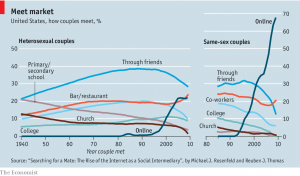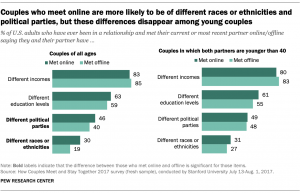7 Dating and Mate Selection
Dating and selecting a long-term partner can be a confusing and sometimes frustrating process. But it can also be a fun and exciting process. Often, our experience depends on what we belief and how we engage in the dating process. Let’s start by talking about beliefs. Many of us have grown up with ideas about falling in love. This ideas come from our family of origin, the media, and other cultural factors. Sometime, we may not even realize the things we believe about dating and falling in love. Below are seven common myths we have about dating and falling in love (Cobb, Larson, & Watson, 2003).
Myth #1 – “The One and Only”
One of the most common ideas that people hold around dating and falling in love, is the idea of “the one” – the person that is your “soul mate,” of the person that you are destined to be with. What’s more, we also tend to believe that this person will be able to be and do everything for us. They will be our lover and our best friend. As psychotherapist, Esther Perel points out, this can be problematic:
As Perel suggests, there is not one person that can give us everything. There is no one person who is “the one” or a “soul mate.” If we have the expectation that there is a “one and only” person out there who can fulfill all of our needs, we are setting ourselves up for disappointment and frustration. Instead, we need to think about choosing a partner from the perspective of “writing a story.” This story will have a lot of twists and turns, problems and pitfall – it is never a perfect story. But, by “writing a story” with a partner, we can learn how to “edit” and change parts of story to make it more interesting and exciting.
Myth #2 – “Complete Assurance”
This myth stems from the idea that we can be completely sure about a decision we are making. However, as Esther Perel points out again, no one is ever completely certain. And uncertainty can sometimes make for a more interesting and exciting story.
The need for certainty often stems from the need for perfection. Often people think, “Until I find the perfect person to marry, I should not get married (Cobb et al., 2003).” However, there is no perfect partner. If we seek perfection in a partner, we will likely end up disappointed. Similarly, we sometimes feel the need to be a perfect partner. As Cobb and colleagues note “No one is ever perfect or feels completely confident to become a spouse. A feeling of personal readiness is important, but individuals may feel some anxiety about the decision.”
Myth #3 – “Love is Enough”
Finally, When we think about dating and finding a partner, often we look for a person that we love. Sometimes, being in love can lead us to overlook certain aspect of a relationship that might be problematic. We may think, “Love is enough to get us through any problem or hardship.” But successful relationships need more than just love. When choosing a partner we need to look for one with whom we can communicate, disagree, and compromise with. We need more than love.
John Gottman has used the term “Emotional Bank Account” to show why love isn’t enough.
John Gottman – Emotional Bank Account
In 2020, Kayla Reed-Fitzke and her colleagues examined these and other mate selection myth to see if people held groups of myths. The found four different types of mate selection groups: 1) Romantics were the most likely to endorse mate selection myths – they believed strongly in the Love is Enough and the One and Only myths; 2) Realists were those who were least likely to believe these myths out of any of the groups; 3) Apprehensive Realists were similar to the Realists but were more likely to endorse the Complete Assurance myth – they didn’t believe in most myths but were apprehensive about finding a partner; 4) Uncertains were often in the middle on each myth – they neither strongly endorsed or strongly disagreed with these myths.
Dating
Whether we believe in this myths or not, technology has changed the way we find partners. Apps like Bumble, Tinder, Grinder, and other along with dating websites like Match.com and Eharmony.com have changed how we meet partners. This was documented by the Economist in 2018. Currently, meeting someone online is the most common way to meet a partner

The change in how we meet people has resulted changing who we couple up with. As noted by Pew Research, couple who meet online are more likely to have racial/ethnic differences.

With all of this new technology, dating and finding a partner can be hard. With a broader pool, comes more options and with more options you can feel the need to just keep swiping. However, in 2018 Christina Wallace offered a suggestion that you might find helpful – the 0 Date. She discusses this idea in her TED Talk:
This strategy might not work for everyone, but it shows the possibilities and pitfalls of online dating and ways in which you can use it to your advantage.
